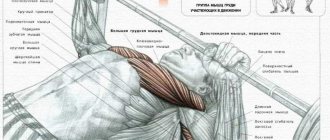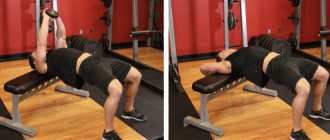Home ▸ Articles ▸ Workouts ▸ How to build muscles: a complete guide from a cool trainer
How to build muscle as quickly as possible is what this comprehensive guide is all about. Become big, strong, slender and built like Apollo.
The techniques you'll learn about will help you overcome terrible genetics and gain good muscle mass if you work hard and smartly. But first the bad news...
If you're a genetically average guy or a "skinny fatty" who's really struggling to gain strength, build muscle, and lose fat, you've probably been lied to. You have been fed a lot of crap about how to transform your body, which will never work for someone like you. For example:
● you should not do anything other than massive strength gains and Olympic-level exercises;
● you should always work extra hard no matter what;
● isolating (isolated) exercises are useless;
● you should always do a full body workout;
● circuit training is the fastest way to get rid of problems;
● crunches and cardio give you six-pack abs;
● you should eat 6-7 times a day;
● You should eat 2 grams of protein per pound of your body weight;
● carbohydrates are the devil;
● You should buy this supplement or take this drug to build muscle mass.
All this is complete nonsense. The only thing you'll get by following these tips is an extensive list of annoying injuries and zero in your checking account. Try Jason Ferrugia's training and nutrition method specifically for skinny, injury-prone guys.
He is a world-renowned strength and endurance specialist and muscle-building expert. And also one of the most sought-after fitness trainers in the United States and “the most controversial personality in the fitness industry” thanks to his bold fitness ideas.
Ferrugia's Renegade Method is ideal for all guys over 35 who need to improve their training as they age. It has been tested on thousands of students and has given amazing results. This method is especially suitable if:
● you have little time;
● you are not taking steroids or performance enhancing drugs;
● you don’t have good genetics to build muscle and strength;
● you're tired of getting injured from training and feeling like crap all the time.
Nobody promises plus 34 kg of muscle in the next month or anything like that. You still need to be patient and take the time. But you'll see some results within a few weeks of this plan, and big results within a few more months.
If you follow the program and work hard, you will get results. Never give up after a few days. Don't look for excuses or an easier way. Don't be sheep. Be lions.
Rule #1: To build muscle, you need to get stronger.
You can't expect to change your physique by doing the same workouts over and over again. You have to force adaptation to happen. The easiest way to do this is to increase the weight of the barbell. Get stronger primarily in the 5-10 rep range and you will get bigger.
Hard training always gives better results than light training. It's just common sense. The more weight you use, the more muscle fibers you can recruit.
How do you know you're getting stronger? Regularly setting personal records. Choose a few key exercises that work your entire body together. Presses, pull-ups, rows, squats and deadlifts are the best choices (more on this in Rules #2 and #3).
Write down how much weight you can currently lift for 5-10 reps of each, and over the next few months work your way up to the point where you can add 4-9kg to each of these exercises or do 3-5 repetitions with the same weight. This is how you make your body grow.
When you reach the upper limit of the rep range, add weight and start again with 5 reps. Simple but extremely effective; no advanced math degree required.
The point is this: to become big, you need to become strong.
Imagine that you have already scored a goal
When you start a business, imagine that you have already achieved what you want. Immerse yourself in this atmosphere. For example, you want a big, muscular body.
Set your thoughts in such a way as if you already possess it. Close eyes. Imagine how shyly beautiful girls look at you, how confident you are, you are always welcome and your opinion is respected, you feel great, your body works like a machine, and not like an “old lady Lada” of domestic production.
Visualize your final image. Our brain is an amazing organ. You yourself will soon begin to notice how your life begins to change. Just don’t forget that simply imagining your ultimate goal, but doing nothing to achieve it, will not lead you to the result. Therefore, be sure to start with PLANNING, which should lead to specific actions.
Rule #2: You Must Use Compound Exercises to Build Muscle
Exercises that allow you to use the heaviest weight will build muscle the fastest. These are also the climbs that allow the greatest percentage increase in load. Here we are talking about complex (multi-joint) exercises with free weights. You won't be able to grow at nearly the same rate if you train on machines and do isolation movements.
You have to overload your body with big, serious, testosterone-producing lifts. The best compound strength exercises to build muscle:
● military presses (overhead) - lifting the barbell while standing from the chest above the head. Also performed with dumbbells or kettlebells;
● Incline bench press – barbell or dumbbell. I like to set the tilt angle to no higher than 45 degrees. Around 30 is excellent. This helps protect the shoulders, which are at high risk of injury during a typical bench press;
● squats - with a barbell on the back, with a barbell on the chest, with a safety bar, a buffalo bar, with a rubber loop;
● deadlift – regular, sumo, with trap bar, Romanian, from platform/racks;
● rowing movements – with dumbbells in one hand, with chest support, landline;
● carried with weights (probably so) - this could be a farmer’s gait or carrying a sandbag or stone in different positions: bear hug, carried on the crook of the elbows, under the chin or on the shoulders;
● working with weighted sleds - pushing or pulling a sled or Prowler.
Get stronger at these exercises by slowly adding weight and reps.
When you can perform an impressive amount of these variations in sets of 5-10 reps, you'll be a big guy.
Development progress: main stages
All progress can be divided into several stages:
- The body prepares for hypertrophy, that is, the growth of muscle fibers. This all takes about 2-3 months. This stage is key in matters of further weight gain. Strength indicators can grow at tremendous speed. Just a few workouts ago you bench pressed 60 kilograms, and today it’s 75-80.
- The process of hypertrophy. At this stage, the most important thing begins - muscle growth. On average, the duration of hypertrophy is not a year or two, but three to five years. But don’t rush to close the page - this is the maximum period. On average, potential can be realized in two years. The experience of thousands of athletes has shown that in two years it is quite possible to raise your weight from 70 to 90-100 kg, even without pharmacology . It is this difference in weight that will be the visible progress that many dream of.
- System adaptation. Here the emphasis is on those aspects that limit the growth of our muscles. That is, attention is paid to the circulatory system, heart, nerves, energy, etc. Unfortunately, only the most persistent reach this stage.
Rule #3: Complement big lifts with bodyweight exercises
Barbell and dumbbell lifts are the foundation, but you'll need more than that to train injury-free and long-term. These exercises should be supplemented with an equal amount of muscle building and body weight building exercises. For example:
● pull-ups;
● push-ups on rings or between boxes while hanging;
● variations of squats and lunges on one leg;
● push-up options;
● Inverted rows - ring rows, but with feet on a bench or box;
● plank options;
● Glute-ham Raises - rises on a Roman chair.
Bodyweight training develops strength and stability throughout the body. They are also gentle on your joints, allowing you to build muscle without straining your connective tissue.
A combination of big lifts and bodyweight exercises will result in an athletic, balanced, muscular physique that will last for years to come.
Is it possible to build muscle at 40?
All of these aspects of training depend on each other, and if one is adjusted, then all the others must also be adjusted accordingly. Those who aspire to be true bodybuilders must be more conscious when increasing the intensity of their training.
This set of recommendations gives the most complete picture of strength training technology and opens the doors of the gym for both young and older athletes. There is no restriction to start building muscle at 40 or 50 years old.
Getting pumped up and sculpted muscles for a man or woman after 40 years of age is no more difficult than for a young person. More often than not, older athletes are more disciplined, while younger athletes find it more difficult to put together a training program. A person with an established career can afford sports supplements and the right amount of rest time and massages, while young guys are most often limited in this.
The human body easily adapts to everything, and if new conditions are not given to it, it will have no incentive to change. Try to create a plan that challenges you with its high intensity and have fun training.
Still in doubt? Watch the training of Alexander Yashankin, one of the brightest popularizers of bodybuilding in the CIS.
Sports nutrition will help speed up the process of quickly pumping muscles - proteins, creatines, gainers, arginines, BCAA, amino acids. These supplements are specially designed for athletes and fitness-active people of different fitness levels. Such drugs are completely safe, and their effectiveness has already been proven.
Rule #4: To build muscle safely, you need to use perfect technique.
Yes, this should go without saying, but walk into any public gym and you'll find that this rarely happens. People will work in any form that allows them to lift weights, but that doesn't mean they did a good rep. The ideal set consists of several components. Here's what you need to do:
● Tense yourself from head to toe before lifting the weight. Squeeze the fingerboard (or other instrument) as if you were trying to crush it. If you do the exercise standing, be sure to tighten your buttocks and abs. Tension throughout the body creates stability, making the lift stronger and safer.
● Control the lowering or eccentric portion of the lift. This helps you control your weight better for safety and hits your muscles harder to promote growth.
● Allow the muscle to stretch in the lower position, but do not go so far that you feel pain. You should also not experience stress on your joints.
● Begin the positive (concentric) portion of the lift by contracting the target muscles forcefully. So, if you're doing a dumbbell press from the bottom up, squeeze your pecs first.
● Do not use excessive inertia. Lift your muscles rather than reflexively stretch. No bouncing reps.
● For barbell exercises, you should lock out at the top and reset for the next rep. Don't try to quickly gain reps.
● For bodyweight and dumbbell exercises, you should stop, simply avoiding lockout at the top, and immediately change direction. Think of constant tension and continuous movement.
Determining Your Entry Level
Some of the things may be very simple for some of you, but remember that this article is intended for beginners to look for quick ways, shortcuts, to build muscles correctly, avoiding common mistakes. If you are a complete beginner, then this is great! But if you are a little more advanced, you can also benefit from this article by simply going through the points that interest you. Not bad?
Everyone will have a different starting point, so I think you understand that it would be impossible to give advice that suits everyone. But I hope this article will help people who really need it.
Rule #5: Train at the optimal volume to build muscle.
For young guys who really want to increase their strength, 5-8 reps are ideal. If you are over 35 or have been training properly for a couple of years, you can increase the reps a little and start doing more sets of 10-12 reps in addition to the 5-8.
As you become more advanced or over 40, you'll want to spend a little more time in the 8-12 rep range and less time in the 5-8 rep range, just to protect your joints from heavy loads and reduce the risk of injury.
Most guys with an average level of training prefer to combine low and high repetitions in one exercise. So, after you've done some serious lifting work, do a few sets of a little more reps and get pumped up.
As you do more reps, focus on the muscle you're trying to build and get the most out of it. Yes, as silly as it may sound, visualizing muscles working and growing during a workout can be helpful.
A 2016 study from the European Journal of Applied Physiology found that when athletes think about their pecs and triceps during exercise, they activate them better.
If you've been training properly for at least three years, you'll find that advanced pumping techniques like rest-pause sets, drop sets, and some of the other old bodybuilding techniques you've no doubt heard of can be beneficial when used in moderation . Just don't overdo it with them. And never stray from the most important rule: make your personal best stronger.
While the number of reps you do per set is important, the total number of reps you do for each muscle group is equally important. The National Strength and Endurance Association has determined that for maximum growth you need approximately 20-70 repetitions per muscle group.
Depending on which end of the rep range you're working on, this can be done in one workout or over multiple days (like a training week), but you need to cover that spread to see gains. This means that if you're doing 6 reps per set, you need to do at least 3 full sets—and more than 12—for that particular muscle group.
Jason Ferrugia recommends starting at the bottom of the scale. Turn up the volume only when absolutely necessary. So, if you're training your chest, you can start by doing 6 working sets of dumbbell presses, split into two sets per workout of three sessions per week. You can then gradually add sets, experimenting with different training splits that will allow you to get more volume without overtraining.
As you progress, you can alternate between phases of lower and higher volume with the help of a properly designed training program.
Comprehensive training program for 2 months
To pump up your abs in 2 months, you should choose a suitable program that allows you to work all the muscles.
Option 1
Do:
- twisting;
- plank (static exercise, you need to lie on the floor, then rest on your toes and arms bent at the elbows, the body is a straight line, you cannot arch your back or lift your buttocks - try to hold out as long as possible);
- deflections (lie on your stomach, legs straight, hands behind your back in the lock. As you inhale, raise your body, fix the position, lower, repeat);
- right angle;
- accordion (sit on the floor, support yourself on half-bent arms behind you. Raise your straight legs, hold them in this position for 3 counts, then bend your knees and pull them to your chest).
Each is done 10-15 times, you need to complete 3 approaches. The plank is held for 30 to 75 seconds, the load gradually increases.
Option 2
Do:
- bike;
- simultaneous lifting of arms and legs;
- pelvic lift;
- raising bent legs;
- reverse twist;
- boat (lie on your stomach, the lower part of the body is aligned, at the same time lift your shoulders and legs off the floor to a height of about 30 cm, fix the position for 3 counts, lower and repeat).
Fitness instructors advise taking 30 seconds of rest between sets, and up to a minute between exercises.
Rule #6: Distribute your training days correctly
First, you don't have to train six days a week like a bodybuilder. Three to four days of heavy strength training per week is ideal for most busy, average genetic people who are not using steroids.
The best training plan is one that allows you to:
● recover correctly;
● increase your strength as much as possible;
● save joints and spine.
The frequency with which you train each muscle group usually decreases the more years you train.
Beginners:
If you are a beginner, you need 3 full body workouts per week. In each, perform a compound pushing movement (eg bench press), a compound pulling movement (eg chin-up), and a compound lower body exercise (eg squat, barbell deadlift). If you want to add 1-2 other exercises to finish, such as weight carries or kettlebell swings, that's fine, but three exercises is enough to work the entire body.
A 2015 study published in the Journal of Strength and Conditioning Research found that subjects who trained their entire body three times a week gained more arm size than another group that split their body parts, working each muscle only once.
Continued:
If you've been training for longer than 6-12 months, you can split your workouts into upper and lower body days. The most common setup is to train the upper body one day and skip the next, so each area is trained twice a week.
If you train four days a week, you could train your upper body on Monday, your lower body on Tuesday, rest on Wednesday, and then do your upper body again on Thursday, your lower body on Friday, and then rest on the weekend.
You should still rely mostly on compound lifts, but adding in some isolation work like shoulder lateral raises and dumbbell bicep curls is okay.
If you train three days a week, you can alternate upper and lower body days each time you train. You can use this method for two weeks:
1 Week
- Monday: upper body.
- Wednesday: lower body.
- Friday: upper body
2 week
- Monday: lower body
- Wednesday: upper body
- Friday: lower body
If you train three days a week and prefer to set your training days each week rather than alternating them, have a hard upper body day on Monday, legs on Wednesday, and then an easier upper body day on Friday when you increase a little number of repetitions and perform less strenuous exercises.
So instead of doing incline barbell presses for sets of 5-6 reps, you can do dumbbell incline presses or weighted ring push-ups for sets of 8-12 reps.
Advanced:
Top/bottom division can always be used. Many big, strong powerlifters stick to this throughout their entire career. However, if you are older and/or have recovery issues, you may prefer a push/pull/legs split where you train all at once once a week. This is how most famous bodybuilders trained in the past, and many continue to do so.
You can do chest, shoulder, and triceps exercises on Monday, back and biceps exercises on Wednesday, and leg exercises on Friday. If you want to train your arms or "beach muscles" (abs, chest, upper back and shoulders) on Saturdays, you can expand these workouts to a four-day-a-week program.
Most typical bodybuilding programs use too many sets and repetitions and use the wrong exercises. However, if you reduce overall volume, go heavier, and use compound movements, there is nothing wrong with splitting body parts for advanced lifters. In fact, it is often less stressful on the joints than a conventional top/bottom pattern.
In terms of frequency, training a muscle group once every 5-7 days is actually safer and more effective for advanced lifters than training it two or three times a week. If you want to increase your frequency a little, there are ways to do it without adding extra training.
You can add one or two lighter sets of work for the muscle group you want to train on days other than your main workout for that muscle. For example, if you want to train your arms, you can do one or two sets of dumbbell curls to begin your leg workout.
How quickly do you gain muscle mass if you are asthenic?
Decide what goal you pursue when going to the gym or fitness center? Of course, anyone has a desire to build muscle mass and acquire a beautiful figure! Skinny guys weighing up to 50 kg want to gain sixty kg, those who weigh up to 60 kg want to reach the weight category of 85 kg, etc. But how to achieve this?
Nutrition for weight gain
Until you have the feeling that you have eaten “densely”, you will not be able to consume the required amount of healthy food in the required volume. Don't eat low-calorie, fiber-rich vegetables; choose foods that are high in calories. Most bodybuilders recommend consuming 40 kilocalories per kilogram of weight to develop muscle strength.
It is wrong to consume mono-products, for example, only vegetables with oatmeal, egg whites with fruit. This is a healthy food, but such a diet is not suitable for gaining muscle mass. You should opt for higher-calorie dishes: pureed vegetables, legumes, meat, whole eggs and dried fruits.
Important! Eat higher-calorie foods, which will help quickly restore and increase the calories burned. The diet should include adequate consumption of a variety of foods. Read more in the article “How to eat during training.”
Let's take a closer look at calories. To gain muscle mass, it is recommended to start with 30 kilocalories per kilogram of body weight for a week, and then gradually increase. For example, a man who weighs 100 kg first needs to absorb 3000 calories per day, and after two or three weeks, increase the rate, and, as quickly as possible, switch to the norm of 40 Kcal per kilogram of weight. The main thing is to gradually increase your calorie intake.
Important! Correct proportions of Protein/Fats/Carbohydrates:
30%/15%/55%
Sport
Muscles grow best when you stress them. When you're strength training, you can get the most out of the process by lifting weights. This way you can achieve maximum tension in your muscles. Pull-ups, deadlifts, weighted squats, and bench presses are best for stimulating multiple muscle groups at once.
You can still build muscle without lifting weights if you put more stress on your body using a different method. Increase the frequency of repetitions of exercises, as this will fatigue your muscles. Increasing the number of repetitions as you progress in the sport will not allow your body to get used to the weight that it knows should no longer increase. If you do 3 sets of 10 reps a week, then do 3 sets of 12 reps the next week and so on, or increase the number of reps. Another option is to reduce the amount of rest between sets to 2-3 minutes.
Eat more protein at every meal
It is impossible to build muscle without protein. It is a natural material for building cells. When you eat, your body uses the carbohydrates, fat and protein you eat to regulate your metabolism. If you eat protein at every meal, you can help your body successfully maintain and build muscle. As a bonus, protein also helps you stay full. Aim to eat about 20 grams of protein at each meal.
Important! The average person should aim to get at least 0.8-1 grams of protein per kilogram of their weight. Once you reach this minimum, you will be able to build muscle without any problem. Get protein from natural foods: eggs, dairy, meat, nuts and lentils.
Although you can eat more protein per pound, there is no definitive evidence that it helps you gain weight faster. At the end of the day, the body will convert the extra calories into fat if you overeat or if your energy demands it. There are online calculators that show you how many calories and protein you should be consuming per day.
Eating protein powder or taking amino acid supplements from sports nutrition
Protein shakes in their pure form do not give the desired result, but act as a productive supplement, enhancing all metabolic processes. The timing of meals also plays a significant role in the rapid absorption of food. It is advisable to do this in portions and strictly by the hour, with 3-4 hour intervals and a 10-hour break for sleep.
If you find it difficult to get all the protein you need for the day from your diet, you can choose a ready-made protein powder. Whey protein is a complete source of protein and an excellent meal replacement. You can also help speed up recovery and endurance during intense exercise. This will quickly improve your results.
Drink enough water
When you exercise, you need to make sure you drink enough water. You need it to prevent dehydration, which can impair muscle recovery.
Consume Carbohydrates Post-Workout
You can still eat carbs while you're actively building muscle. If you want to make it easier to gain muscle mass, you can strategically plan the times when you eat carbohydrates to benefit your body. It's best to consume carbohydrates after a workout. Your body will burn calories more efficiently - this will help prevent local fat accumulation.
Fractional meals
Always remember that you should do everything that goes against standard diet principles if your goal is to gain muscle mass. Instead of cutting calories, you should eat more calories and do it more often. This tells your body that it has a constant supply of energy needed for muscle growth. This way, your body doesn't have to go through the stress of deciding what to do with calories and what to turn them into (fat or muscle), like it does when you don't eat enough.
Try to eat every 3 hours, and provide 3 full meals a day and three to four high-calorie snacks. Contrary to popular belief, you cannot burn fat and build muscle at the same time. You either don't eat enough or you overeat. You can't do both at the same time.
Get more rest
Muscle growth naturally requires recovery. Be sure to get plenty of rest to allow your body to expand its muscles. When you sleep, your body releases growth hormone, which further helps build muscle mass.
Train properly
Work smarter, not harder, when it comes to getting a good workout in the gym. Once you understand the intricacies of the process, you will see results. Perhaps you are doing something wrong and don't know it. By following these muscle building tips, you'll be able to break out of your plateau and reach your goals in no time.
Three main factors will help you achieve your goal: regular training with heavy compound exercises, adequate rest and a nutritious diet with excess calories. If muscle building does not occur, you need to look for which of these links is not working.
Why can't you gain weight quickly?
There is no consensus on which training or nutrition plan is right for you. For example, some people focus on sports nutrition and need more calories, while some athletes spend more time training. You should tailor your training and diet to your needs, but don't ignore the following tips.
Replace single exercises
Most training plans consist of a combination of compound and isolation exercises, such as the big bench press (compound exercise) and flying (isolation exercise). The difference between the two is that combining these exercises work more muscle groups than isolation exercises, so you can train with more weight on one hand, and on the other hand, your body releases more hormones, especially testosterone hormone and growth hormone, especially important for building muscle mass.
So if your training plan contains more than one isolation exercise for each body part except the calves, biceps, shoulders and forearms - these are almost always isolation exercises - then drop a few of them and replace them with more challenging combination variations.
Always challenge yourself
If you do the same type of training for several months without increasing the load, the body will adapt to it and the muscles will not grow.
Get out of your comfort zone: Love bench presses but not push-ups? Then do push-ups at the beginning of your workouts and as often as possible. Listen to music, chat with friends during training and the exercise will become enjoyable, and your training will fly by.
Train with an experienced trainer
Occasionally pushing your limits can be very dangerous. For example, if you take a high load and pull the barbell as high as possible while bench pressing, you run the risk of being crushed by the barbell or suffering some other type of injury. This is where a learning partner can help, providing the security and motivation you need. A coach who pushes you and puts you in the right frame of mind can have a positive impact on your results.
Read about how to choose a coach here.
Invite your friends to train. Let's face it: if one of your buddies is watching your progress, it's easier than doing it on your own to do one more rep or put an extra weight on the bar.
Do one approach at a time until the muscles are maximally tense.
As described in point two, you must push your limits, and often beyond, every workout. However, as a US study has shown, training to exhaustion on each set is counterproductive. The study measured the strength of athletes who performed the bench press for eight weeks - five sets per workout.
The result: those who trained to maximum muscle tension were able to gain greater strength and therefore muscle gains than athletes who did not train to high muscle tension. Switching to exercises before muscle tension is much more productive, but takes a lot of time to recover. If increasing the number of repetitions per approach does not improve strength indicators, but only exhausts the muscles, then you should change tactics.
Eat more food before bed
If you're having trouble building muscle, another meal you should add to your meal plan is a bedtime snack of slow-digesting protein. For example, granulated cheese or a casein protein shake.
During sleep, which should last at least eight hours, your body is fasting. At this time, it may lack important nutrients, especially if, like most hard gainers, you have a fast metabolism and dinner has already been used up. Slow-digesting proteins and carbohydrates are processed by the body overnight and promote muscle growth better than fast-digesting protein in sports nutrition kits.
To gain muscle mass, you not only need to eat food every hour, but also regularly weigh yourself and count calories. If, with daily weighing, the weight does not increase by at least 500 grams, then you should review your diet, introduce more bioavailable food into the diet and increase the frequency of meals. Of course, constantly preparing a variety of dishes will tire anyone; the ideal option is sports food. This is a concentrated set of the most necessary and bioavailable substances. But remember that harmonious weight gain is impossible without gainers, creatine, and vitamin complexes.
Healthy food delivery on the Grow Food promo codes .
Rule #7: “Stimulate, don’t destroy”
This is a quote from eight-time Mr. Olympia Lee Haney. This means you need to train hard, but smartly.
Don't kill yourself in the quest to become big and strong. When you leave some gas in the tank, both at the end of each set and after each workout, you increase your chances of success.
Don't push sets to failure where you absolutely can't do another rep. You should never get to the point where you turn purple and scream. In most cases, you'll want to finish the sets two reps before failure. Not sure when this will be? The moment your form breaks or you are almost certain it will break, end the set.
I like a great analogy: balancing training and recovery is like digging a hole. Every time you rise, you dig deeper and find it difficult to get out of the hole. To get out again, you must fill the hole to get back to ground level, and the only way to fill it is by eating and resting. If you overdo it in the gym, pushing too hard, you won't be able to train as often or as hard. Eventually you will get injured.
Now about the numbers
In conclusion, let us summarize our reasoning. So, for the average person to achieve success in bodybuilding, he needs 2-3 years. Moreover, after a year of active training, you will be able to see a certain result. The main thing here is not to stop and continue your development. Bodybuilding should not be just a sport for you. This is a way of life. There are athletes who have been training for 15-20 years, but have not yet achieved maximum results.
If someone claims that you can pump up your body in a couple of months, don’t believe it. One year is a realistic period for people with good genetics, two to four years is necessary for everyone else.
Rule #8: Stay fit
Cardio does NOT make you small and weak, even if you are a skinny athlete to begin with.
Skipping endurance work will make you lazy, out of shape, with a fat butt. Endurance exercise will help you stay lean and athletic, and improve your recovery between strength training sessions. This is very beneficial and should be part of your weekly routine.
Jason Ferrugia's favorite form of cardio is high-intensity interval training (HIIT). It has been proven to be extremely effective at burning fat and increasing fitness levels while preserving muscle mass.
You should still do at least one 15-30 minute HIIT workout per week, even if you're trying to build muscle as quickly as possible. If you are trying to lose weight, you should do 2-3 HIIT workouts per week.
To do HIIT correctly, pick an exercise (or series of exercises) and try to perform it as quickly and as hard as possible for 30 to 60 seconds. In fact, for the sake of safety, it is preferable to give 90-95% of your maximum effort. Then you coast (or rest, depending on the exercise) for 60–120 seconds. Repeat the sequence for 15-30 minutes.
Jason Ferrugia's Favorite HIIT Exercises
● Uphill sprint
● Sprint while pushing or pulling a weighted sled
● Sprint on a high-resistance bike
● Kettlebell swings or snatches performed with high repetitions
● Jumping rope
● Swimming
● Rowing (if your back can handle it)
In addition to your HIIT sessions, it's always a good idea to take a 30-60 minute walk as many days a week as possible. It is recommended to take at least 10,000 steps every day. Use a phone app to track them.
If you jog, swim, hike, or do any other form of long-lasting, low-intensity cardio exercise, you can do that as often as you like.
Proper nutrition during training
Let's consider the principles of nutrition for those who plan to build muscle mass and get the maximum effect when pumping the body at home.
1. Eat more protein. It’s easy to calculate the amount - per 1 kg of weight there should be 1.5 grams of protein. For example, your weight is 80 kg, which means your protein requirement per day is 120 grams.
Which foods contain enough protein:
- red meat - beef, pork, lamb;
- fish - tuna, salmon, swordfish, perch, trout, mackerel;
- poultry - chicken, turkey, duck breasts;
- eggs, especially egg whites;
- dairy products - milk, cheese, cottage cheese, yoghurts.
2. Consume complete proteins.
What is the difference? It's simple - if the protein is of animal origin, it is considered complete. If you're a vegetarian, don't worry either. Complete proteins can be obtained from beans, lentils, buckwheat, and rice.
3. From carbohydrates, choose complex ones, not fast ones.
Fast carbohydrates are baked goods, fast food, and foods high in sugar. Complex - various cereals (oatmeal, brown rice), durum wheat pasta, rye bread, etc.
4. Eat healthy fats.
Do you remember about the BJU balance? Fats are there too and they are important, even if your goal is to pump up at home and get ripped abs. In general, you should get 20-30% of your daily calories from fat. The right fats are fish, nuts, cold-pressed oils, flax seeds, pumpkin seeds, etc.
Rule #9: Make recovery a priority
Training is simply a stimulus for growth. You grow outside the gym when you recover; not during training. If you can't recover, you won't grow. Simply and easily.
So how can you ensure proper recovery after training? Adhering to the following:
● don't do more than you can do in the gym;
● do not train for more than an hour at a time;
● do not use extreme levels of psyche in each approach;
● keep stress under control;
● sleep 8–9 hours every day;
● meditate;
● perform at least 15–20 minutes of mobility exercises and self-myofascial release (for example, foam rolling);
● doing some low-intensity exercise and/or yoga (or other stretching exercises) on weekends;
● take contrast baths and showers;
● Get a massage once a month or as often as you can afford.
Diet
Nutrition needs to be given special attention:
- Try to consume only complex carbohydrates, exclude sweets and starchy foods.
- Load up on protein foods.
- Add sports nutrition to your diet. To gain quality mass, use amino acids and protein shakes.
Do you need cardio activity? In my opinion, before doing the exercises, you can spend a maximum of seven minutes on the treadmill, but while gaining weight, I remind you that we are talking about ectomorphs, you should not run daily.
Bonus Rule: Consistency is Key
All the information above will be completely useless if you do not apply it consistently. It's not about the week. We are not talking about two months.
The greatest progress is made by those who consistently perform 3-4 workouts per week. The guy who never skips a meal, always goes to bed on time, spends several hours a week on home restoration techniques, and repeats this process 52 weeks a year, year after year. This is how real progress is made.
You have to commit and believe in what you are doing. You can't change your routine after a week. You can't constantly be on the Internet looking for the best program.
There are no magic supplements or yet-to-be-discovered secret training techniques that will help you build 100 pounds of muscle in the next three months. These things will never happen.
The only thing that produces results is passion, commitment and hard work. Every damn day.
Lift weights. There are steaks. Run up the hills. Sleep. Repeat.
Set achievable goals
Planning should be very detailed, the more detailed the better! If, for example, you come to the gym on the first day and immediately hang 100 kg on the barbell, while your bench press is 50 kg, then even 55 kg will seem very heavy.
Most likely, you will simply be crushed by this weight, and you will also receive serious injuries. And all because the goal must be specific and ACHIEVABLE! To raise your bench press from 50 kg to 100 kg you have to go through a difficult path. Set yourself a goal: in 2 months you can bench press 60 kg, then 70 kg, and then 80 is just around the corner.
When you see previously completed tasks in your diary, it will stimulate you to achieve more and more new goals and motivate you to take further action.
But when you already squeeze 95 kg, the last 5 kg will seem funny to you! After all, you have already gone through a journey of 45 kg before achieving the result!











